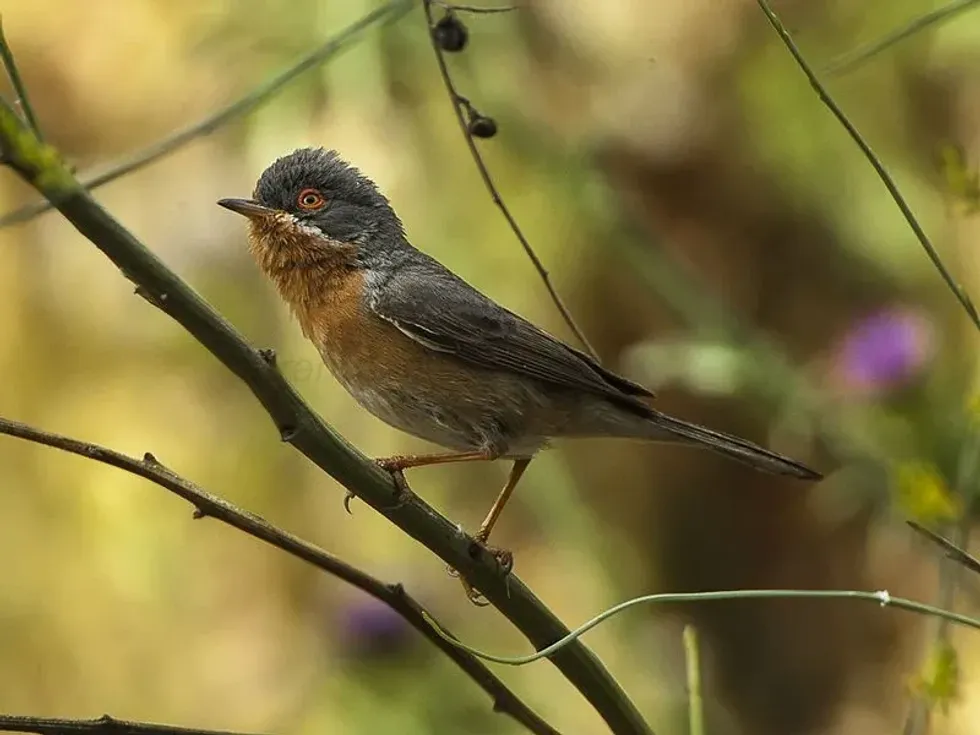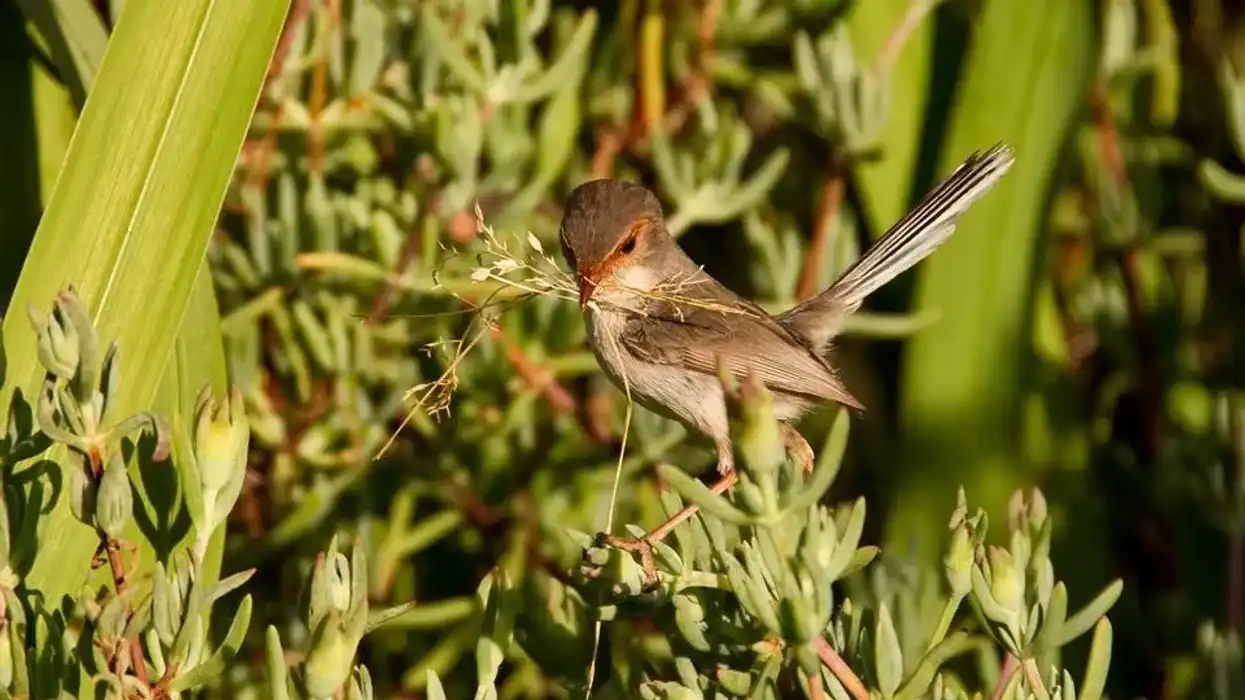The subalpine warbler (Sylvia cantillans) is from the family Sylviidae and the genus Curruca. The subalpine warbler range consists of southern regions of Europe and this bird breeds in the northwest area of Africa.
Winters are spent in the southern part of the Sahara and they are known to be vagrants to Great Britain.
The habitat of this species includes a warm and dry summer climate for breeding and this bird tends to live on hillsides that are sunny with scrubs that are prickly. The breeding of this bird happens in April to June in southern Europe and May to June in Algeria.
The nests of these birds are placed low in bushes.
These nests are made or built with grass, stems, leaves, roots, and stalks and are lined with fine grass, hair, and rootlets. Around three to five eggs are laid and the incubation is done by both parents for about 11-12 days.
The male and female birds of this species tend to have differing plumages. An adult male of this species has a gray-colored head and back and underparts are brick-red in color.
Also, they tend to have malar streaks or mustaches that are white in color whereas a female of this species is known to be brown generally with a grayish color head.
The underparts are white in color and they tend to have a pink tinge or flush. This species is known to have a long tail.
The diet of this species mainly consists of larval and adult insects as well as fruits like berries in late summertime and fall. Three subspecies of this species have been recognized, the western subalpine warbler, the eastern subalpine warbler, and the Molotoni's warbler.
Western and eastern subalpine warblers are commonly found in Italy in different parts and the western one is also found in southern France.
The Molotoni's warbler is endemic to the Mediterranean islands including Sardinia, Corsica, and the Balearic islands. The subalpine warbler call is related to that of the lesser whitethroat.
It is very interesting to explore and learn about the subalpine warbler (Sylvia cantillans). For more relatable content, check out these yellow warbler facts and pine warbler facts for kids.
Subalpine Warbler Interesting Facts
What type of animal is a subalpine warbler?
The subalpine warbler is a type of bird belonging to the Sylviidae family which is divided into two genera, genus Curruca and genus Sylvia.
What class of animal does a subalpine warbler belong to?
The subalpine warbler bird is classified in the class of Aves of birds and family Sylviidae.
How many subalpine warblers are there in the world?
There is no specific number available for the global population of these warblers but it has been recorded that in Europe, there are around 1,400,000-3,200,000 breeding pairs of these birds.
Where does a subalpine warbler live?
The breeding range of these warblers consists of southern regions of Europe and they breed in the northwest Africa. Winters are spent in the southern part of the Sahara and are known to be vagrants to Great Britain.
The eastern subalpine warbler (Cantillans albistriata) is found in parts of Italy and Turkey. The western subalpine warbler (Sylvia or Curruca iberiae) is found in parts of Italy, southern France, and Africa. The Moltoni's warbler is known to be endemic to the Mediterranean islands including Sardinia, Corsica, and the Balearic islands.
What is a subalpine warbler's habitat?
The habitat of this bird, subalpine warbler (Sylvia cantillans), consists of a warm and dry summer climate for breeding. These birds tend to live on hillsides that are sunny with scrubs that are prickly.
Who do subalpine warblers live with?
Not much is known about the behavior of these warblers and whether they are solitary birds or live in groups. Groups of warblers are known by a number of collective nouns like wrench, fall, bouquet, and confusion of warblers.
How long does a subalpine warbler live?
The life expectancy of this bird is not available.
How do they reproduce?
The breeding of this bird happens in April to June in southern Europe and May to June in Algeria. Nests tend to be placed in low bushes or low trees.
The nests are placed 11.8-59 in (30-150 cm) above the ground. The nest of this bird is deep and built with grass, stems, leaves, roots, and stalks and is lined with fine grass, hair, and rootlets. Around three to five eggs are laid and the incubation is done by both parents for about 11-12 days.
What is their conservation status?
These birds are placed under the Least Concern category of conservation status by IUCN.
Subalpine Warbler Fun Facts
What do subalpine warblers look like?
This bird is a small and slender warbler with a long tail. The male and female plumage of this species is different. An adult male has a gray-colored head and back, underparts which are brick-red in color, and a puffy throat and breast.
The belly is white. The male also tends to have malar streaks or mustaches that are white in color. A female is brown or has a brown plumage with a grayish color head.
The underparts are white in color including the belly and females tend to have a pink tinge or flush. Females are considered to be a faded version of males. These birds tend to also have naked eye-rings.
How cute are they?
These birds are considered cute because of their size and color.
How do they communicate?
Communication of these birds takes place through various types of songs, sounds, and calls, just like other bird species. The song of this species is similar to or related to the lesser whitethroat and is explained as rattling and fast with 'tjrek' and dry 'tek' calls.
How big is a subalpine warbler?
Subalpine warbler birds are around 4.7-5.1 in (12-13 cm) long and are slightly smaller than a purple finch and are also smaller than a fox sparrow.
How fast can a subalpine warbler fly?
The flying speed of a subalpine warbler (Sylvia cantillans) is not available.
How much does a subalpine warbler weigh?
The weight of these warblers ranges from 0.3-0.5 oz (9-13 g). They are smaller than blackpoll warblers and in a similar range to cerulean warblers.
What are the male and female names of the species?
Males and females of this species do not have any particular names.
What would you call a baby subalpine warbler?
Baby warblers just like other baby birds are called chicks or young ones.
What do they eat?
The food of the subalpine warbler (Sylvia cantillans) mainly consists of larval and adult insects. These birds also feed on fruits like berries in late summertime and fall. A warbler also feeds on scrubs and on the foliage of trees like oaks and olives.
Are they dangerous?
No, these birds are not considered dangerous.
Would they make a good pet?
Not much information is available about this species as pets but it is believed that these birds are wild and migratory and would not make great pets.
Did you know...
Three subspecies of the subalpine warbler have been recognized. These are the western subalpine warbler, eastern subalpine warbler, and Moltoni's subalpine warbler.
These birds are migratory and the species is known to be a long-distance migrant.
A molecular phylogeny of the taxonomy of Sylvia cantillans complex that has been published states that this species is a polytypic species or complex and a split in the taxonomy or split in the complex is recommended.
Do subalpine warblers migrate?
Yes, these warblers are migratory. During the breeding season, they are found in the southern regions of Europe and the northwest area of Africa. For the winter season, these birds migrate to the southern part of the Sahara.
How to tell male and female subalpine warblers apart?
Male and females of this species tend to have certain differences in plumage that help to tell males and females apart. Differences include red underparts and gray upperparts and white-colored cheek streaks in an adult male whereas an adult female has brown upperparts, white on the underparts with some flush of pink.
Here at Kidadl, we have carefully created lots of interesting family-friendly animal facts for everyone to discover! Learn more about some other birds from our least tern interesting facts and puffin surprising facts pages.
You can even occupy yourself at home by coloring in one of our free printable Subalpine warbler coloring pages.









